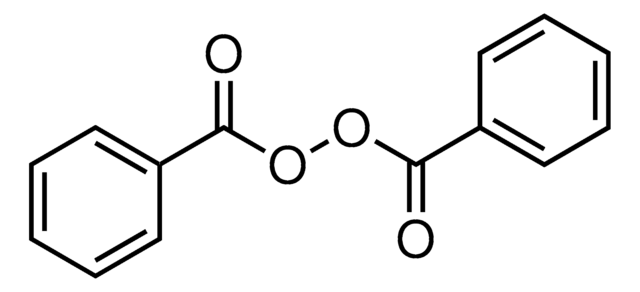179981
Luperox® A98, Benzoyl peroxide
reagent grade, ≥98%
Synonyme(s) :
Benzoyl peroxide, Dibenzoyl peroxide
About This Item
Produits recommandés
Qualité
reagent grade
Niveau de qualité
Pureté
≥98%
Forme
solid
Température d'inflammation spontanée
176 °F
Pertinence de la réaction
reagent type: oxidant
Pf
105 °C (lit.)
Chaîne SMILES
O=C(OOC(=O)c1ccccc1)c2ccccc2
InChI
1S/C14H10O4/c15-13(11-7-3-1-4-8-11)17-18-14(16)12-9-5-2-6-10-12/h1-10H
Clé InChI
OMPJBNCRMGITSC-UHFFFAOYSA-N
Vous recherchez des produits similaires ? Visite Guide de comparaison des produits
Catégories apparentées
Description générale
Application
- Thermal cross-linking of multiwalled carbon nanotubes (MWCNTs) via radical-initiated reaction
- 3-D crosslinked carbon scaffolds
- poly(lactic-co-glycolic) acid (PLGA), MWCNT and singlewalled carbon nanotubes (SWCNT) scaffolds
Informations légales
Mention d'avertissement
Danger
Mentions de danger
Conseils de prudence
Classification des risques
Aquatic Acute 1 - Aquatic Chronic 1 - Eye Irrit. 2 - Org. Perox. B - Skin Sens. 1A
Code de la classe de stockage
4.1A - Other explosive hazardous materials
Classe de danger pour l'eau (WGK)
WGK 2
Point d'éclair (°F)
Not applicable
Point d'éclair (°C)
Not applicable
Faites votre choix parmi les versions les plus récentes :
Déjà en possession de ce produit ?
Retrouvez la documentation relative aux produits que vous avez récemment achetés dans la Bibliothèque de documents.
Notre équipe de scientifiques dispose d'une expérience dans tous les secteurs de la recherche, notamment en sciences de la vie, science des matériaux, synthèse chimique, chromatographie, analyse et dans de nombreux autres domaines..
Contacter notre Service technique










